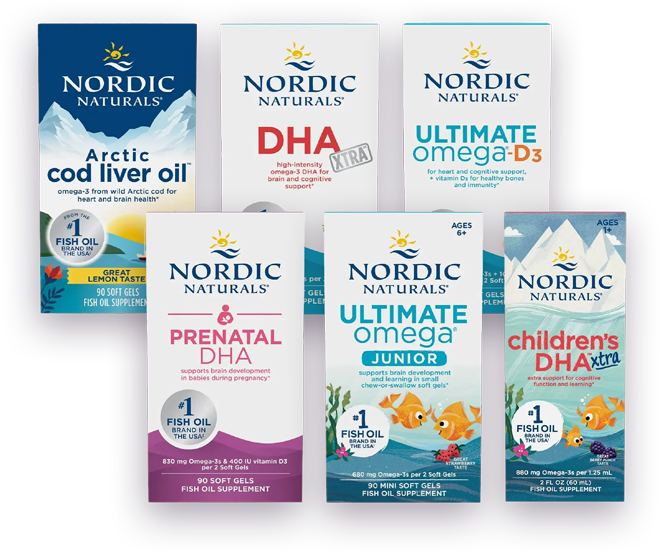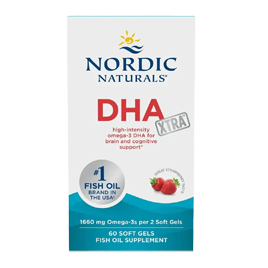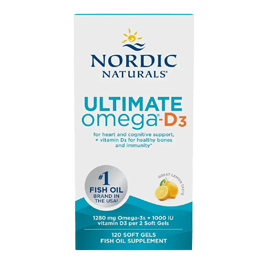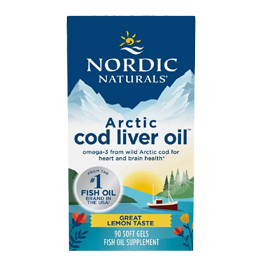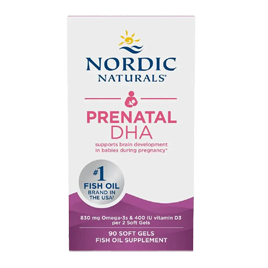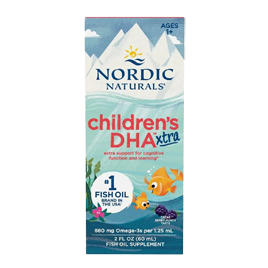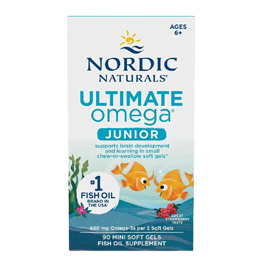

Why choose Nordic Naturals?
Nordic Naturals manufacture all products in Norway, where they adhere to the highest manufacturing standards guaranteeing exceptional product purity and freshness levels. All their products are molecularly distilled utilising the latest distillation technology, yielding positively zero trans fats. This process guarantees the removal of any heavy metals (lead, mercury etc), PCB’s and dioxins.
All of Nordic Natural’s omega-3 fish oil products are produced in the triglyceride form, which is the form naturally found in fish and the form the body most easily recognises and absorbs. Triglyceride-form fish oils require more manufacturing steps, and take longer to produce, but for Nordic Naturals there is no other way. Their patented oxygen-free manufacturing process allows them to deliver industry-leading purity and freshness levels documented by third-party test results.
New Products
DHA Xtra
Our most potent DHA formula for intensive cognitive support, DHA Xtra™ packs almost 1000mg of pure omega-3 DHA into a single serving.


Ultimate Omega-D3
Ultimate Omega®-D3 combines healthy doses of two essential nutrients for optimal wellness, omega-3 EPA+DHA and vitamin D3, in a concentrated serving.


Arctic Cod Liver Oil™
Sustainably sourced in Norway, our award-winning Arctic Cod Liver Oil™ is the gold standard.


Prenatal DHA
Prenatal DHA is a pure and fresh source of the omega-3s that your growing baby needs for brain and nervous system development, and that support a healthy pregnancy for you


Children’s DHA Xtra
For kids ages 1-6
A new liquid concentrate for children who don't eat enough fish, this formula provides three times the omega-3 DHA as our original Children's DHA product for extra support for cognitive health.


Ultimate Omega Junior
For kids ages 6-12
Ultimate Omega® Junior offers a potent, kid-sized serving of omega-3s to benefit brain health, mood, and learning, in a smaller, strawberry-flavoured soft gel that’s easy to swallow or chew.


Not all fish oils are the same


3rd party purity test


Better absorption


Freshness guaranteed


Non GMO verified


Reduced waste


Friend of the sea ®


Great taste


Sustainable ingredients


Research backed ingredients


100% biofuel
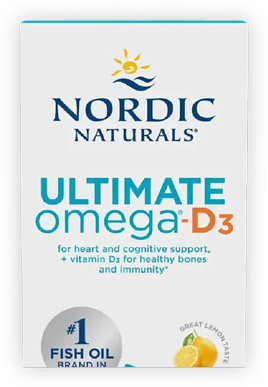

Why everybody needs omega-3s
The human body is made up of approximately 37 trillion cells, and each of them contains important omega-3 fatty acids that the body needs to stay healthy and function normally.
EPA (Eicosapentaenoic Acid) and DHA (Docosahexaenoic Acid) play important roles throughout the body as influential structural components of cell membranes. However, the human body cannot produce the essential fats needed to create these important omega-3 fatty acids on its own, which is why we rely on outside sources like cold-water fish and flaxseed to get the EPA and DHA we need for optimal cellular health and functioning.
Questions & Answers
q: What are essential fatty acids (EFAS), & why do we need to take Omega-3 EFAS?
Essential fatty acids (EFAs) are polyunsaturated fats that our bodies need but cannot produce. Therefore, they must be consumed through food or supplements. There are two families of EFAs: omega-3 and omega-6, which need to be consumed in a balanced ratio. The body must receive a balanced supply of omega-3 and omega-6 EFAs to ensure proper eicosanoids production. Eicosanoids are hormone-like compounds that affect virtually every system in the body - they regulate the inflammatory response, help maintain proper blood pressure and cholesterol levels and promote fluid nerve transmission. The problem is that, in our modern industrialised food system, omega-3s have become largely absent from the food chain while omega-6s, particularly damaged omega-6s, have become overabundant. Even the healthiest diets contain too many omega-6s and not enough omega-3s. Decades of scientific evidence indicates that this EFA imbalance can contribute to a variety of chronic health issues. The most beneficial omega-3s that we’re missing are EPA (eicosapentaenoic acid) and DHA (docosahexaenoic acid).
q: Can we get enough Omega-3s from the food we eat?
Fish is the primary food source of the omega-3s EPA and DHA, but in England we simply don’t eat enough fish on a regular basis. Even those who eat fish several times a week aren’t getting enough EPA and DHA because much of the fish consumed today is farm-raised and lacks significant amounts of EPA and DHA. Also, many people are increasingly avoiding fish due to growing concerns about environmental toxins in fish (such as mercury, dioxins, PCBs, etc.).
In addition, there are several factors that can lead to reduced absorption of EFAs: age, poor diet, alcohol consumption, low levels of certain vitamins and minerals, some prescription drugs, compromised immune status, and a diet high in saturated and/or trans-fatty acids (meat, dairy, fast food, fried food, baked goods, and processed foods. Moreover, people with health challenges or those who are currently deficient often require a minimum of 2-4 grammes a day of EPA and DHA, which is difficult to obtain from fish alone.
q: What is the relevance of balancing the Omega-6:Omega-3 ratio?
Over the past 100 years, changes in the food supply in Western nations have altered the type of dietary fatty acids we consume, leading to a dramatic increase in the ratio of omega-6 to omega-3 fatty acids. This increased omega-6:omega-3 ratio is known to influence a poor nutritional state that contributes to higher incidences of many chronic diseases. To address this omega-6:omega-3 imbalance, current recommendations suggest increasing the consumption of pre-formed omega-3s EPA and DHA in fish and/or fish oils, increasing intake of ALA (the essential omega-3 fatty acid, alpha-linolenic acid found in vegetables, flax, fruits) and decreasing intake of LA (the omega-6 linoleic acid in meat, dairy, eggs, vegetable oils).
q: If we get too much Omega-6 in our diet, then why does Nordic Naturals offer products that contain an Omega-6 (e.g. Nordic GLA, Complete Omega, Omega Woman)?
Omega-6 fatty acids (Linoleic Acid or LA) are found mainly in corn, soybean, safflower, and sunflower oils and, although essential, these fatty acids are over-consumed and out of balance with omega-3 fatty acids in the modern Western food supply. In processed foods the omega-6 fatty acids are often adulterated too. For these reasons, omega-6 supplementation is rarely needed for non-strict-vegan westerners. However, there is one type of omega-6 (Gamma Linolenic Acid, or GLA which is the next step in the metabolism of LA) that does require supplementation. GLA is found in few sources such as borage and evening primrose oils. Used in some Nordic Naturals formulas, GLA promotes the production of beneficial prostaglandins and supports healthy skin, brain function, mood, joint, and cardiovascular health. It is most effective when taken along with the EPA and DHA in fish oil.
q: Do pregnant women need Omega-3s?
It is especially important for pregnant and breastfeeding women to consume DHA (one of the omega-3s in fish oil) because the developing baby is dependent on Mum! DHA is an essential fatty acid - we must get it from diet or supplements because our bodies don’t make it - and consuming enough DHA is critical for normal and healthy development of infant brain, eyes, and nervous system. Additionally, inadequate consumption of DHA during pregnancy has been linked to sub-optimal mood health for women after pregnancy.
Experts recommend that women consume 300-600 mg of DHA daily while pregnant and breastfeeding. Nordic Naturals DHA, Prenatal DHA, and Ultimate Omega all satisfy this dosage, each providing 450 mg DHA per serving. As with any supplement, it is best to consult your health care professional.
q: What about other beneficial Omega fatty acids like Omega-5s, Omega-7s, Omega-9s? Do we need those too?
All non-concentrated fish oils contain a myriad of other omega fatty acids besides the omega-3s EPA and DHA. The average fish oil contains 23 omega fatty acids. Any quality fish oil manufacturer should be able to provide a chromatogram listing the levels of all the omega fatty acids found in their fish oil. Often, when fish oil is concentrated, some of these other fatty acids will be removed in order to increase the amounts of EPA and/or DHA. You often hear the most about the omega-3s EPA and DHA because those are the fatty acids that have been shown, by decades of scientific research, to yield important health benefits for every cell, organ, and system in the body, and are considered the most functional omega-3s. They are also drastically deficient in the food supply of Western nations, making it very difficult for us to get adequate amounts from our diet.
q: What should I look for when purchasing a fish oil supplement to ensure high quality?
- Third-party test results for purity and freshness. A third-party certificate of analysis indicates the levels of purity from environmental toxins, and the oxidation level (or freshness) of the oil. Certificates of Analysis are available on the Nordic Naturals website; simply enter your lot number to view the certificate for your specific bottle.
- Manufacturing standards. Is the fish oil manufactured according to international quality standards?
- Smell and taste. Does the fish oil smell or taste fishy? If so, the fish oil has most likely been exposed to oxygen and is becoming rancid. Rancid (oxidised) oils should be avoided, as they yield less-than-healthy effects. Avoid fish oils that have really strong flavourings added to them because they are most likely trying to hide the fishy flavour of rancid oil.
- Triglyceride molecular form. Research has shown that triglyceride form omega-3s are up to 70% better absorbed than synthetic ethyl ester omegas.
- Supportive scientific research to prove the efficacy of the fish oil brand.
- Sustainable fishing practices. Any environmentally responsible fish oil manufacturer should offer transparency into their fishing practices.


